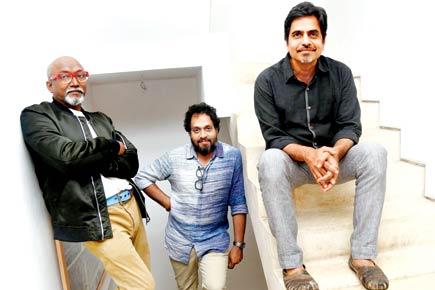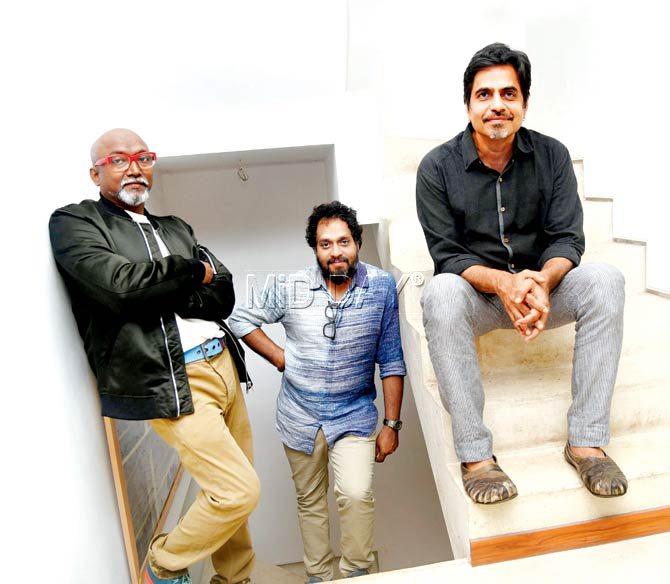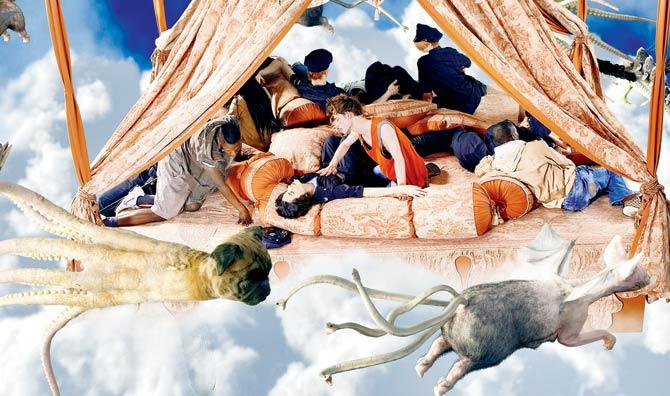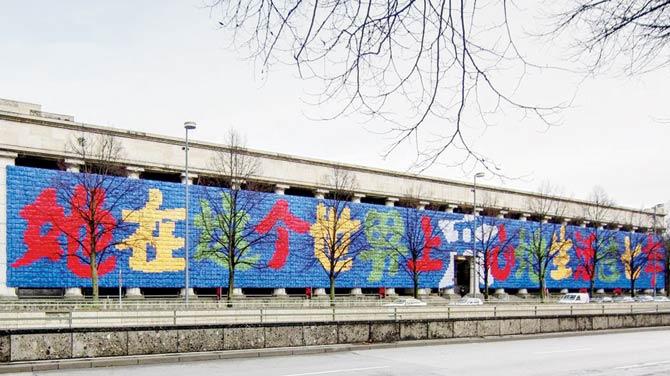The men behind the Kochi-Muziris Biennale 2016, on bridging the gap between the traditional and the contemporary at this year's biggest art event

(L-R) Kochi-Muziris Biennale (KMB) co-founders Bose Krishnamachari and Riyas Komu, and curator for KMB 2016, Sudarshan Shetty at his Chembur studio. Pic/Sameer Markande

(L-R) Kochi-Muziris Biennale (KMB) co-founders Bose Krishnamachari and Riyas Komu, and curator for KMB 2016, Sudarshan Shetty at his Chembur studio. Pic/Sameer Markande
Of all the quarters that artist Sudarshan Shetty thought he would receive curatorial advice from, an autorickshaw wallah was the last person he expected. As curator for the third and upcoming edition of Kochi-Muziris Biennale (KMB), Shetty has made monthly trips to the port town this year, where he befriended an autorickshaw wallah.
ADVERTISEMENT
"He said he was thorough with past editions of the Biennale and let me know that if I needed any suggestions for South American artists, he would be the man to go to," recalls Shetty, adding, "This kind of engagement at a biennale is rarely seen elsewhere in the world. People come in busloads to be a part of the KMB; they read wall texts and watch long video works patiently."
At his studio — a maisonette in Chembur with sculptures stacked in corners — Shetty is seated on a black high-back club chair, with the rain pattering furiously on the windowpane behind us. On a red couch beside him are Bose Krishnamachari and Riyas Komu, co-founders of the KMB. This is a rare moment — when all three can be found in one room in Mumbai — a breather from the projects they are part of in India and abroad.
After an intense year of presenting the upcoming edition to various patrons, Shetty released the curatorial note and the full list of 89 participating artists (and counting) last week with the mission to keep one of Asia's major art festivals as "the people's biennale". "During the Biennale, some cafés in Kochi have Biennale fish on their menu. [Artist] Mithu Sen once shared a video where the nariyal wallah was selling 'biennale paani'," adds Krishnamachari, whom Shetty teasingly calls "Bose the Boss".

A still from Inverso Mundus, an HD video installation by Russian art collective AES+F. The group will participate in the upcoming edition of the Kochi-Muziris Biennale. Pics/Kochi Biennale Foundation
Back to the future
Once Shetty orders masala dosas and idlis for everyone (not because he has a penchant for Udupi hotels but because these are "the only safe things to eat"), he narrates how the theme for KMB 2016 — "forming in the pupil of an eye" — came about. It is a verse gleaned from the poetry of Sharmistha Mohanty, also a participating artist. "I wanted to play with the idea of continuity, about looking at the past and the future, inward and outward," he says.
Compare this with KMB's earlier themes — Kochi as the centre of cosmopolitanism in 2012 and Kochi as the legendary maritime gateway in 2014 — and Shetty's theme sounds less specific. "The concept note sounds a bit cryptic and is deliberately open-ended. I wanted to open up ways of having conversations with people who are seemingly outside of the expectations of the contemporary art space," he explains, adding that Kochi — a city with more than 30 non-Marathi speaking communities have lived over the centuries — continues to be a muse. It's diversity, which inspired KMB 2012 and 2014, is still at the heart of Shetty's curatorship.

A 100-metre-long installation made out of 9,000 children's backpacks by Chinese artist Ai Weiwei in Munich in 2009. It appeared in So Sorry, his video work shown in the first edition of KMB. Weiwei was recently banned by the Chinese government from the Yinchuan Biennale, curated by Krishnamachari
For the 55-year-old artist, who has exhibited at London's Tate Modern, this is his first role as curator. He was chosen by a 10-member advisory committee, which included artist Atul Dodiya and art patron Kiran Nadar. KMB's co-founders, who were also part of the committee, had, among their suggestions, that it should be an artist who curates the Biennale, rather than a critic or curator.
"Indian art needs to go through a transformation, which has to be deliberate; this can emanate from the artist as creator, artist as curator and artist as a partner with other artists," he says, hoping that there will be an end to looking at Kerala — and, by extension, Indian art — through Eurocentric models and post-Enlightenment thought. Let's hark further back, to the pre-Enlightenment days, he suggests, bringing up academician Dr Dilip M. Menon's essay on artist 'Kesari' Balakrishnan Pillai and the invention of Europe for modern Kerala: Is Rome a chapter in the history of Kerala or is Kerala a chapter in the history of Rome?
Shetty has been mulling over these concerns for the last year, and longer as an artist. "To be able to look back in order to be able to perform for the future — within this space the contemporary and the traditional are at loggerheads. The Biennale plays with these questions constantly. What if we were able to present them without the opposition?" says Shetty.
Which is why, this time, when KMB 2016 opens on December 12, contemporary dancer Padmini Chettur will present a modern rendition of 'varna' and Anamika Haksar will present a theatrical production specially adapted for KMB 2016 with Marathi poet and Dalit activist Namdeo Dhasal's poetry. On a wall opposite Haksar's piece, there will be muralist PK Sadanandan's work on a narrative drawn from Kerala.
There will also be a series of works by photographer Mansi Bhatt on prosthetics. When we ask if these will be at Aspinwall House — a sea-facing heritage property that functions as the primary venue of KMB — Shetty shrugs and replies, "I don't want Aspinwall House to become the centre of everything."
In an attempt to assimilate the city as wholesomely as possible, Argentinean writer Sergio Chejfec will spread his text as a graffiti-novel across the walls of Kochi. "It will be like a treasure hunt, so that by the time you finish reading his work, you would have covered a major part of the city," explains Shetty.
The critics will weigh in and point out that this year's KMB features more than a desirable share of performances. We also want to know what's the space for contemporary performance artworks in KMB 2016? Shetty blurs the line. "I don't want to make a distinction like that — between performances and performance works. There are a number of traditional practices in India that are eminently contemporary. How can you bring a classical musician, like a Rajasthani folk musician, into the Biennale? It can't happen, except through performances," he says.
Mothering Biennales
Krishnamachari believes that several other biennales have been inspired by the Kochi-Muziris version. "We have become something of a case study, for it is not easy to bring in local participation," says Krishnamachari. Making 'biennale' a household term, he cites the example of a local school in Pattathanam, Kollam, Kerala, where a students' biennale was conducted during the vacations.
Bose also curated the maiden edition of the Yinchuan Biennale in China, which opened on September 9. Two weeks before the Yinchuan Biennale opened, Chinese contemporary artist Ai Weiwei was dropped from the list under the orders of the Chinese government.
Ironically, Ai Weiwei was the first artist to be signed up by Krishnamachari and Komu when Kochi Biennale debuted in 2012. That time too, the Chinese government barred Weiwei from appearing in Kochi, but the show went on with two of his video works. "In Kerala, with its history of social action, an argument for censorship cannot sustain. It has been about the upliftment of people, a movement from bottom to top," says Komu.
 Subscribe today by clicking the link and stay updated with the latest news!" Click here!
Subscribe today by clicking the link and stay updated with the latest news!" Click here!







